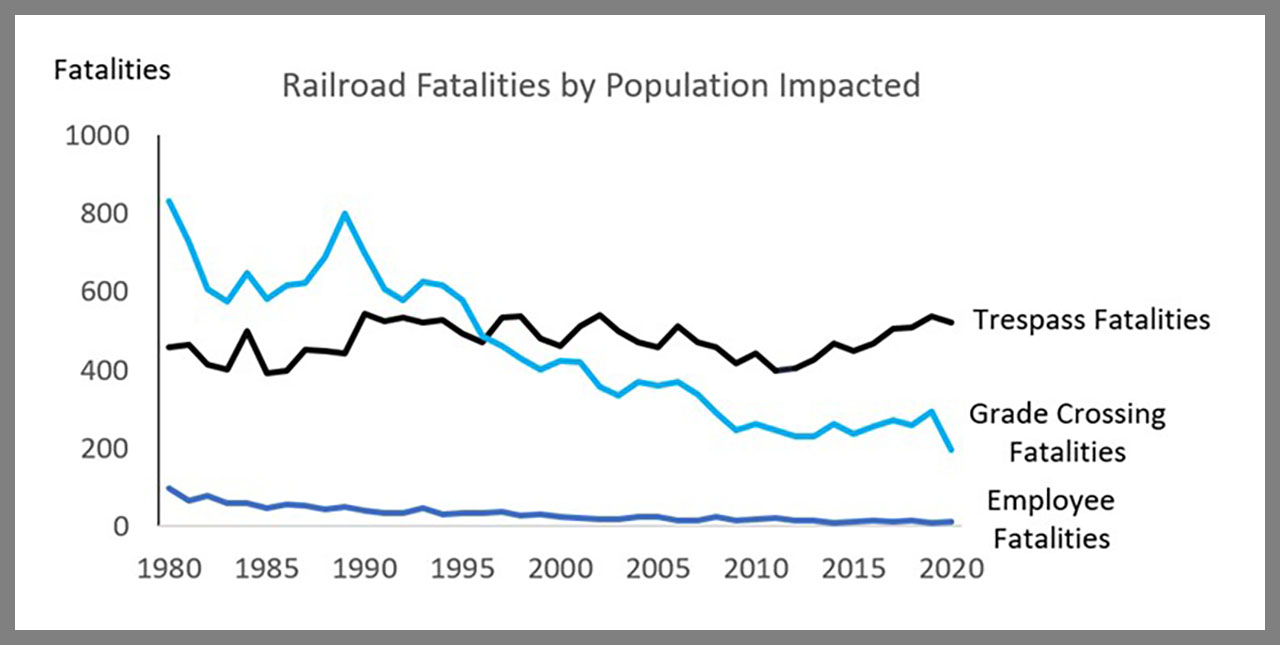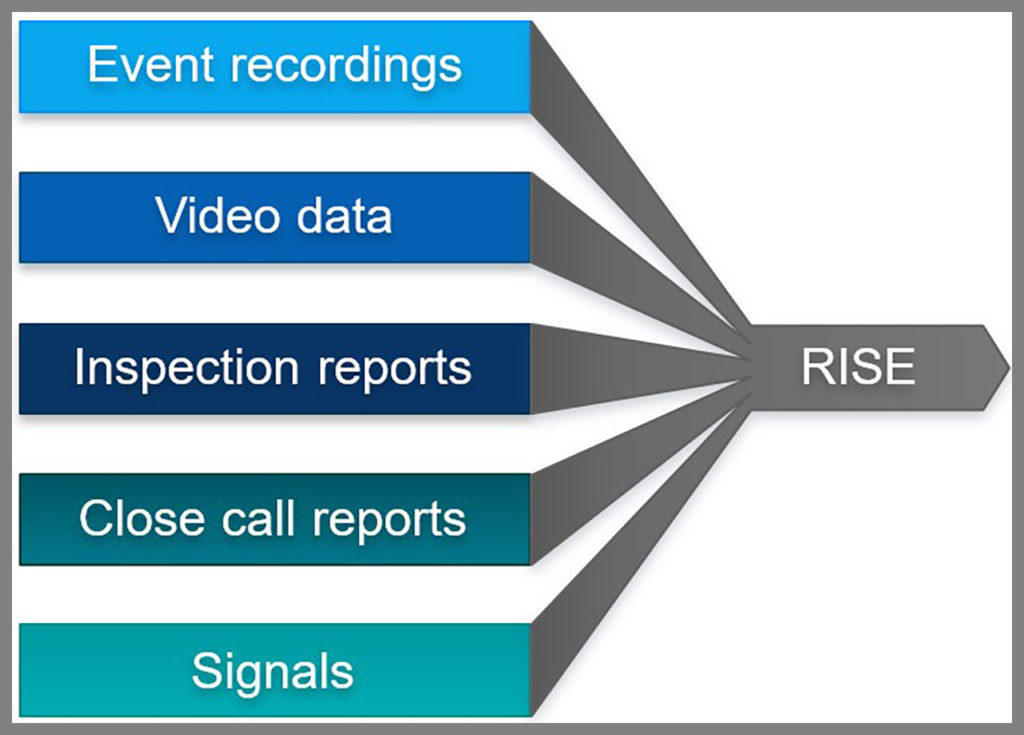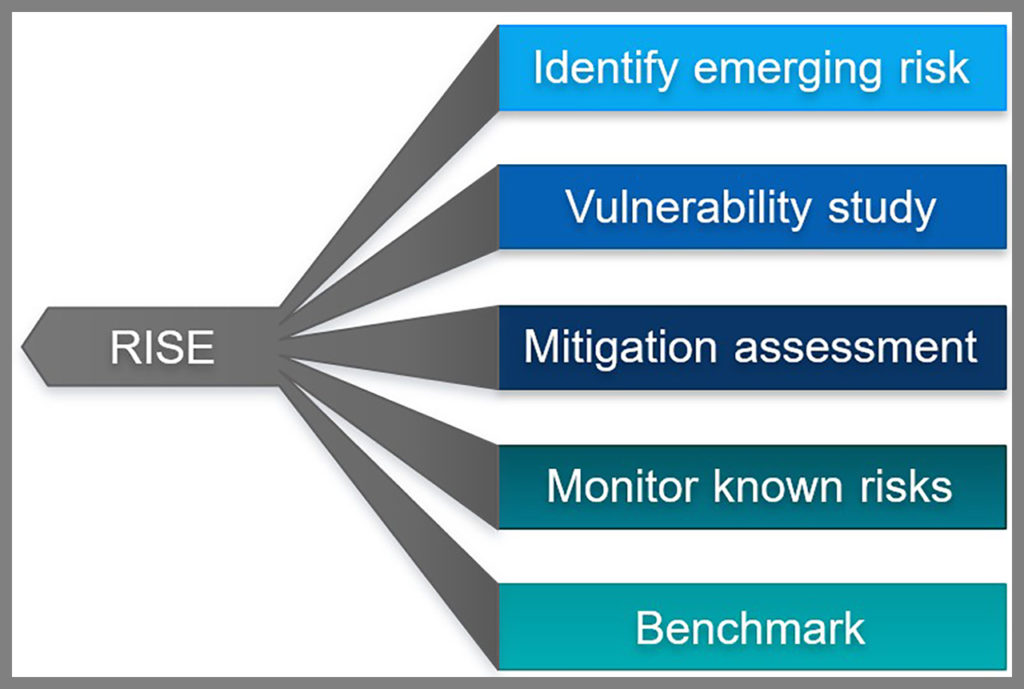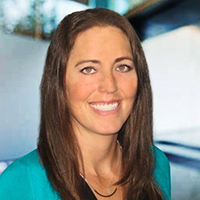
Solving Big Safety Problems with Big Data: FRA RISE
Written by Dr. Starr Kidda, Human Factors Division Chief, FRA Office of Research, Development and Technology
Figure 1. Railroad fatalities by population impacted. FRA illustration.
Despite tremendous progress in railroad safety over the past 40 years, some statistical measures of safety performance indicate that we have reached a plateau. For example, fatalities have plateaued since 2011 and in some cases increased.
While train accident rates have plateaued, we know that railroads are becoming more complex and are collecting more data than ever. New technologies such as energy management systems and Positive Train Control increase the level of automation in railroad operations. Changes in how railroads operate (e.g., Precision Scheduled Railroading) alter the use of employees, equipment and infrastructure. These new technologies and operating practices have created interdependencies that make it more difficult to identify the causal mechanisms that contribute to safety failures. No one person or group has a truly complete picture of how the industry operates. Therefore, perspectives from numerous sources must be integrated to fully understand safety outcomes.
Bringing together many perspectives in the form of people from different disciplines, multiple railroads, vendors, regulators, and labor representatives provides an opportunity to better identify, evaluate and manage risk and safety performance.
The Federal Railroad Administration (FRA) Office of Research, Development and Technology (RD&T) recognizes these trends and is building an infrastructure for sharing data between railroad stakeholder groups—a data trust. Such a data trust is a voluntary, non-regulatory, evidence-driven safety partnership between FRA and railroad industry stakeholders. This article introduces the Railroad Information Sharing Environment (RISE), its initial development and pilot testing, and offers an invitation to participate.
What is a Data Trust?
The U.S. Department of Transportation (DOT) defined a data trust in a January 2021 DOT Order as follows:
“A tool for sharing sensitive data among trust members for advancing safety or other public benefits when there might otherwise be strong disincentives or significant barriers to sharing.”
It states further, “Data trusts advance transportation safety by encouraging a non-regulatory approach to public-private collaboration and bringing new data sources to spur discovery and innovation.” An independent steward (i.e., a trusted third party) stores and protects data that stakeholders provide to a data trust. Per the DOT Order, “the independent steward takes on a legally binding obligation to hold, protect, and analyze the members’ data in accordance with the members’ direction, within the data trust’s governance rules and any applicable law.”
What is RISE?
The RISE data trust is a mechanism to help railroad stakeholders form a more complete understanding of the interdependencies in the railroad network—all with the goal of improving safety. RISE uses data streams collected by stakeholders to answer railroad safety questions and provide new insights. With a variety of data streams and data in a central location at their disposal, stakeholders can identify emerging risks that can’t be independently or in an individual database.
Working collaboratively, stakeholders participating in the RISE data trust can make sense of separate data streams to gain real-world insights. In addition to identifying emerging risks, participating stakeholders can develop new ways to assess and mitigate vulnerabilities. They can demonstrate and evaluate the impact of mitigation measures and monitor known risks. Finally, RISE will allow stakeholders to benchmark their individual performance against the industry as a whole on specific safety issues for which they would otherwise have limited or no information.


What is the Status of the RISE Data Trust?
From May 2019 to March 2021, FRA conducted a pilot project to test the feasibility of RISE. Five commuter railroads volunteered to participate.
In the pilot project, the University of Maryland, A. James Clark School of Engineering, Center for Advanced Transportation Technology Laboratory (UMD CATT Lab) served (and continues to serve) as the trusted party to collect and manage the data. FRA, the Volpe National Transportation Systems Center and the five railroads set up a governance structure for how the group would operate and make decisions regarding the use of the data. The stakeholders identified personal injuries as a specific topic to investigate. Specifically, they wanted to benchmark their organization’s reportable and non-reportable personal injuries against their peers’ data.
The CATT Lab spent several months collecting, standardizing, and aggregating data from the five commuter railroads and FRA. Next, the CATT Lab created a series of Tableau charts for the stakeholders to view to support benchmarking and analysis.
FRA interviewed representatives from each railroad following the completion of the Tableau visualization charts. Railroad representatives provided their opinions about the value of the output and RISE data trust. All stakeholders deemed the pilot project worthy of their time and effort; they unanimously indicated this initiative should continue and expand. The ability to benchmark their data against peers provided valuable information to inform decision making.
What are the Benefits of Participating in RISE?
RISE offers participants significant opportunities including:
- Having a seat at the table where perspectives are shared about the safety issues of greatest concern.
- An ability to identify emerging safety risks faster and before they become bigger problems since RISE will aggregate data across multiple stakeholders.
- Access Big Data analytics and use advanced data science analysis tools.
- Contribute to and benefit from peer-to-peer contacts and pooled subject matter expertise.
FRA believes the RISE data trust may drive significant improvements in railroad safety. We need to break down the barriers between stakeholder groups and share those experiences, policies, and data. RISE also offers the opportunity for railroads and other stakeholders to share safety-sensitive data without fear that it will be improperly shared or exposed.
Can My Organization Participate in RISE?
Yes! FRA hopes that all railroad industry sectors will volunteer to participate in RISE, including but not limited to all classes of freight railroads, additional commuter railroads, labor unions, industry and trade organizations, manufacturers and suppliers, and universities conducting railroad research.
For additional information about the RISE data trust, or to volunteer to participate in the next RISE information sharing meeting with stakeholders, please contact Dr. Starr Kidda, [email protected], 202-493-1300.
In the meantime, you can learn more about RISE from two recent FRA Technical Reports:
· Lessons from the Railroad Information Sharing Environment (RISE) Pilot Project. This report prepared by the Volpe Center describes the RISE pilot project and identifies opportunities to improve and expand RISE.
· Railroad Information Sharing Environment (RISE) authored by the UMD CATT Lab.
Additionally, data trusts have proven to be effective tools for advancing safety in other modes. Learn more about other DOT data trusts: ASIAS (FAA) and PARTS (NHTSA).

Dr. Starr Kidda is the Human Factors Division Chief within FRA’s Office of Research, Development and Technology. She had led and supported railroad safety research at FRA since 2013 on numerous projects including those related to grade crossing safety, trespass and suicide prevention, and the Short Line Safety Institute. Prior to joining FRA, Dr. Kidda was a program analyst for the Department of Health and Human Services, Office of Inspector General. She Kidda holds a B.S. in Psychology from Davidson College and a Ph.D. in Industrial/Organizational Psychology from the University of Georgia.



